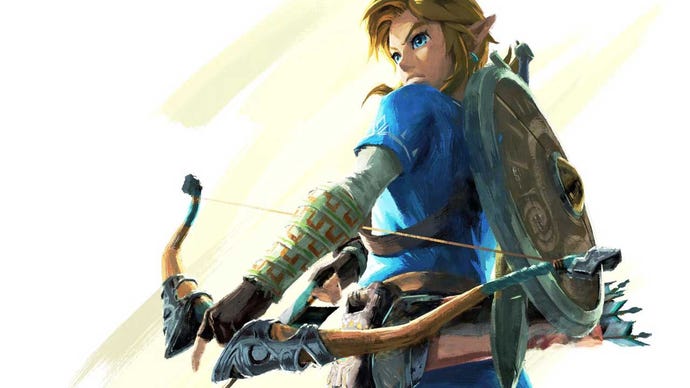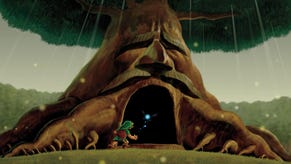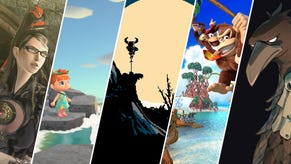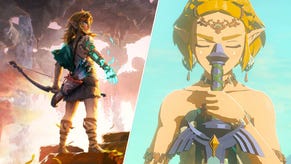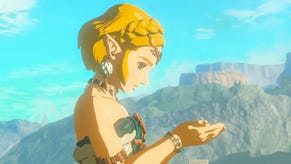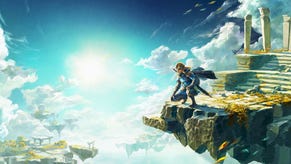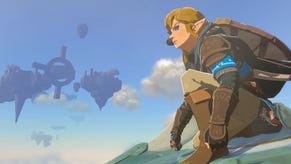The Legend of Zelda: Breath of the Wild is a return to Nintendo's prime at last
The Legend of Zelda: Breath of the Wild ended up as my favourite game of E3. If you'd told me that beforehand I'd have considered it impossible.
"Key to Nintendo's vision for Breath of the Wild is tossing out almost everything they've done to the series since 1986. You can sense the touch of Skyrim or even Assassin's Creed on this title, and that's a good thing."
Let's get my Zelda credentials out of the way up top: I've played all the titles in the main series, but I'm thoroughly convinced somewhere in the last decade or so it lost its way, especially on console. I really disliked much of Skyward Sword, and the verbose, lengthy intro of Twilight Princess actually made me furious when I tried to replay its recent re-release. My favourite Zelda is Link's Awakening, but I count Ocarina of Time, Wind Waker and of course A Link to the Past among the finest games ever made.
After playing a little over half an hour of The Legend of Zelda: Breath of the Wild and watching a lot more, I feel fairly convinced that a fifth Zelda entry could be about to join that list of all-time gaming classics.
Key to Nintendo's vision for Breath of the Wild is tossing out almost everything they've done to the series since 1986. The team appears to have built from there - the first game - on up, cherry-picking only the best elements from later Zelda titles alongside inspiration from all manner of current popular titles. I feel one can sense the touch of the likes of Skyrim or even Assassin's Creed on this title, and that's a good thing.
What you get then is an introduction that lasts a matter of minutes rather than the hours of Twilight and Skyward, and a huge open world you're thrown into with next to nothing on you. There's shades of the original Zelda here; it offers you a few story beats and then off you go, out into a wild open world.
Then there's where the Zelda tropes, even from the first game, are being pushed aside. Take the sword and shield for instance; where in previous games Link would use one of a few different options throughout the game, the acquisition of each a major event, here weapons are just found. They're left around the ruined world, dropped by enemies or looted in their camps. Each weapon has visible statistics on how much damage it'll do and a level of durability. Weapons break forcing you to think on your feet and gather new ones.
When you acquire a bow, you won't do so from one specific quest in one specific dungeon. Here again you'll find it on an enemy, and arrows fired at you that miss can be snatched up to be used as ammunition yourself.
One of the strangest moments for me came when I was weak after a battle against a group of enemies. Like most 3D Zelda games, enemies explode in a flash of bright light after they're defeated. I turn the camera towards it: where's the hearts? There aren't any. Chopping grass and the like won't yield health replenishment, and neither will defeating enemies. Instead, you'll want to carry health restoratives in the form of food and such. Even food is found in a much less Zelda-like way, at least in the demo I played. You actually hunt deer or other animals, gathering ingredients then cooking them at camps.
There's a streak through this that feels like a survival game, or like when you boot into a more 'serious' Skyrim playthrough that simply focuses on exploration. There's elements that feel outright weird for Zelda such as a meter that tells you if you're making a lot of noise in order to aid on-the-fly stealth - but it all just absolutely bloody works.
The idea, it seems, is to allow these systems to intersect to make for some cool emergent moments. If you're short of food, you might find some where enemies camp out. You could fight them head-on, but if you want to save weapon durability you could equally cause a distraction, then stealth in and steal their food supplies. It's cool stuff.
This is a 3D Zelda game that has a jump button and the ability to climb almost any surface with ease within the confines of your stamina meter. Crafting becomes vital here, as gear and potions can increase your stamina or survivability, especially in a world where hearts aren't popping out of every defeated enemy and smashed pot. Everything seems to have multiple uses - you can straight up throw weapons away (ideal for causing the previously-mentioned distractions), and Link's shield can be sat on to surf down steep inclines. Axes can be used as weapons, but also to chop down any tree or smash open rocks for resources.
"Nintendo is slightly scared, it's cornered with its back against the wall and it's all the more innovative and deadly for it."
There's even an item that doubles up as a pair of binoculars used to survey the map and 'mark' things from a distance. The map looks absolutely massive, incidentally - Nintendo's saying 12-times Skyward Sword, and I believe it; this is a map that might be GTA5 size - in a Nintendo game. In a Zelda game! It's madness.
All this may sound a bit gushing, but frankly that's just because that's how this demo left me feeling: it's more or less a week since I played Breath of the Wild, but I can't stop thinking about it. The systems and mechanics on offer seem like they could mesh in fascinating ways to create something incredibly fun. For the first time in many years, I'm excited for Zelda again. And I haven't even touched on some of the other abilities that could be found in the demo, such as the ability to freeze an object in time and manipulate it while it's frozen, or the ability to pick up anything metal with a giant magnet, which feel like very traditional Zelda items but take on a more open-ended role within this demo.
Questions remain, of course. For one we have no idea how progression will actually work in this more open game or what form dungeons will take outside of shrines, smaller 'one puzzle' tower dungeons that are spread throughout the map. Conceptually you should be able to run right to the final boss from the moment you take control - you'd just get crushed - and that's interesting in itself.
There's also the big old hardware elephant in the room. Let's face it: Wii U isn't very good. The machine never seemed like it was going to have the software, something I said back at E3 2012. Zelda is arriving far too late, good at it looks. Its painterly, Studio Ghibli-like art style works well on the Wii U, but my gaze now turns to the NX: what will it and its control method bring to the title? One wonders how much of this game was actually designed for the Wii U. The demo doesn't use the gamepad for anything. It merely displays the controls, which also feel like they could use some reworking, throughout.
Even with control woes, huge structural question marks and the NX unknown, The Legend of Zelda: Breath of the Wild was the best thing I saw at E3. It felt like the best Nintendo. It's slightly scared, it's cornered with its back against the wall and it's all the more innovative and deadly for it. I sincerely hope the full game lives up to the promise of this demo, as if it does the NX may already have its killer app.
The Legend of Zelda: Breath of the Wild is out in 2017 for NX and Wii U.
